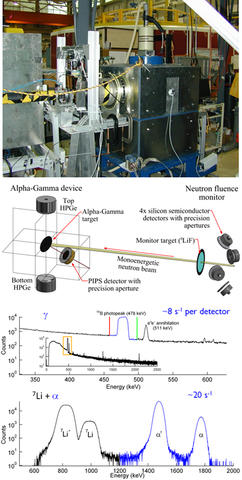Basic Metrology: Alpha-Gamma Counting for High Accuracy Neutron Fluence Measurement
Summary
The Alpha-Gamma device is a totally-absorbing neutron detector that has been used to measure the absolute neutron fluence of a cold, monoenergetic neutron beam to 0.06% uncertainty. This represents a five-fold improvement in the state of the art in neutron fluence measurement. This capability was used to improve the uncertainty in the neutron fluence determination in the previous NIST beam neutron lifetime measurement, and the apparatus is currently being used to calibrate the neutron fluence monitors that are part of the most recent version of the NIST beam neutron lifetime measurement BL2. The first direct absolute measurement of the 6Li(n,t)4He neutron cross section at sub-thermal neutron energy is also well underway. In addition, competitive and systematically-distinct measurements of the 10B(n,α)11B,10B(n,γ)11B, and 235U(n,f) neutron cross sections are being investigated. Finally, the apparatus will soon be used in a recalibration of the national neutron standard NBS-1, providing an entirely new calibration technique and improvements in uncertainty.
Description

(Top) Photograph of Alpha-Gamma detector setup with the 1/v detector shown to the left. (Middle) Schematic of the neutron monitor calibration setup. (Bottom) A typical alpha and gamma spectrum from the thin 10B target.
The absolute fluence of a monochromatic neutron beam has been measured with a totally absorbing alpha-gamma counter. The counter absorbs the entire beam in an enriched 10B4C target and infers the incident neutron rate by counting gamma-rays from the reaction n + 10B → 7Li + α + γ (478 keV) with calibrated gamma detectors. The detection efficiency for the 478 keV capture gamma is measured in a calibration process that successively transfers the well-known activity of an alpha source (Pu or Am). The alpha source is used to measure the detection efficiency of an integrated charged particle detector. A thin 10B target replaces the alpha source, and the beam is turned on. The observed rate of alpha particles is used to determine the neutron absorption rate in the target and the observed gamma rate per neutron absorbed is established. The thin target is then replaced with the totally absorbing 10B4C target to measure the absolute neutron rate.
The primary use for the alpha-gamma counter has been to calibrate a "1/v" neutron monitor based on neutron absorption in a thin 6Li target. The monitor detects alphas and tritons from the reaction n + 6Li → α + t in charged particle detectors masked by precision apertures. Prior to calibration with the alpha-gamma counter, the detection efficiency of the monitor was determined to 0.3% uncertainty from knowledge of the density of 6Li in the target (0.25% uncertainty), the 6Li thermal neutron cross section (0.15% uncertainty), and the detection solid angle (0.1% uncertainty). This was the limiting source of uncertainty in the NIST neutron lifetime measurement using the beam technique.
To calibrate the neutron monitor, it is operated with the alpha-gamma counter on a monochromatic neutron beam. The detection efficiency of the monitor is determined to a precision of 0.06 % by measuring the rate of alphas and tritons in the monitor, the neutron rate with the alpha-gamma counter, and the energy of the beam via a de Broglie wavelength measurement with a Si crystal analyzer. The five-fold improvement in the neutron monitor calibration allows for immediate improvement of the beam lifetime result.
The 6Li(n,t), 10B(n, α), and 235U (n,f) cross sections are important neutron cross section standards. Precise knowledge of these cross sections is essential because they are often used as reference standards for obtaining the neutron fluence in investigations of the properties of neutron-induced reactions and for accurate determinations of other neutron cross sections. They are also used for fluence determinations in neutron dosimetry as well as fundamental physics experiments. Using the alpha-gamma apparatus to calibrate additional thin 6Li, 10B, and 235U deposits will allow for direct systematically-independent absolute measurements of these cross sections at near-thermal energies.
Finally, the national neutron standard NBS-1, a RaBe photoneutron neutron source, is an artifact standard that was most recently calibrated more than 40 years ago. It should be recalibrated using an updated technique. Its current relative uncertainty is 0.85%. Alpha-gamma can be used to calibrate a neutron beam incident into a specially-built fully-absorbing manganese bath. The calibration of the bath obtained in this way can be transferred via a 252Cf source to NBS-1 providing both a new calibration method and a reduction in relative uncertainty.

